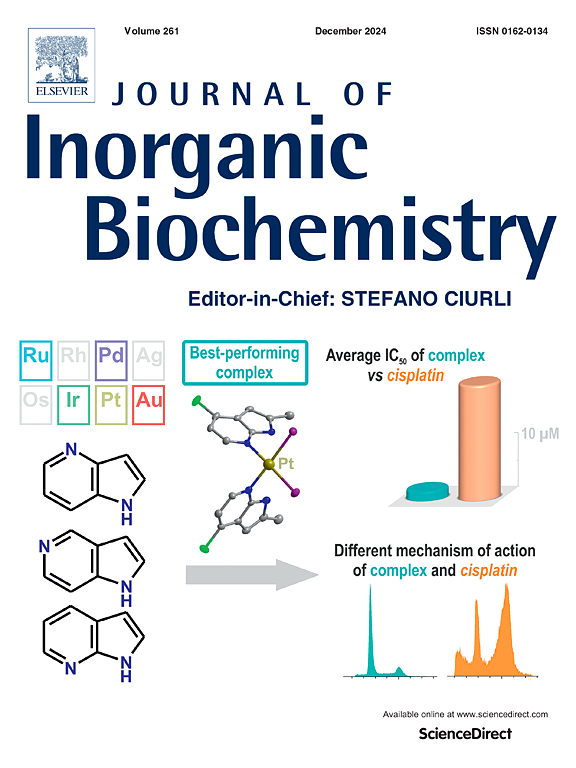Regulation of ferryl reactivity by the cytochrome P450 decarboxylase OleT
IF 3.8
2区 化学
Q2 BIOCHEMISTRY & MOLECULAR BIOLOGY
引用次数: 0
Abstract
The cytochrome P450 OleT catalyzes the decarboxylation of long-chain fatty acid substrates to produce terminal alkenes using hydrogen peroxide as a co-substrate. The facile activation of peroxide to form Compound I in the first step of the reaction, and subsequent C![]() C bond cleavage mediated by Compound II, provides a unique opportunity to visualize both ferryl intermediates using transient kinetic approaches. Analysis of the Arrhenius behavior yields activation barriers of ∼6 kcal/mol and ∼ 18 kcal/mol for the decay of Compound I and Compound II respectively. The influence of the secondary coordination sphere, probed through site-directed mutagenesis approaches, suggests that restriction of the donor-acceptor distance contributes to the reactivity of Compound I. The reactivity of Compound II was further probed using kinetic solvent isotope effect approaches, confirming that the large barrier owes to a proton-gated mechanism in the decarboxylation reaction coordinate. Hydrogen-bonding to an active-site histidine (H85) in the distal pocket plays a key role in this process.
C bond cleavage mediated by Compound II, provides a unique opportunity to visualize both ferryl intermediates using transient kinetic approaches. Analysis of the Arrhenius behavior yields activation barriers of ∼6 kcal/mol and ∼ 18 kcal/mol for the decay of Compound I and Compound II respectively. The influence of the secondary coordination sphere, probed through site-directed mutagenesis approaches, suggests that restriction of the donor-acceptor distance contributes to the reactivity of Compound I. The reactivity of Compound II was further probed using kinetic solvent isotope effect approaches, confirming that the large barrier owes to a proton-gated mechanism in the decarboxylation reaction coordinate. Hydrogen-bonding to an active-site histidine (H85) in the distal pocket plays a key role in this process.

细胞色素P450脱羧酶OleT对铁基反应性的调控
细胞色素P450 OleT以过氧化氢为共底物催化长链脂肪酸底物脱羧生成末端烯烃。在反应的第一步中,过氧化物容易活化形成化合物I,随后由化合物II介导的CC键裂解,为使用瞬态动力学方法观察这两种铁基中间体提供了独特的机会。化合物I和化合物II衰变的Arrhenius行为分析得到的活化势垒分别为~ 6 kcal/mol和~ 18 kcal/mol。通过位点定向诱变方法研究了二级配位球的影响,表明限制供体-受体距离有助于化合物i的反应活性。利用动力学溶剂同位素效应方法进一步研究了化合物II的反应活性,证实了大的屏障是由脱羧反应配位中的质子门控机制引起的。在这一过程中,与远端口袋中活性位点组氨酸(H85)的氢键起着关键作用。
本文章由计算机程序翻译,如有差异,请以英文原文为准。
求助全文
约1分钟内获得全文
求助全文
来源期刊

Journal of Inorganic Biochemistry
生物-生化与分子生物学
CiteScore
7.00
自引率
10.30%
发文量
336
审稿时长
41 days
期刊介绍:
The Journal of Inorganic Biochemistry is an established international forum for research in all aspects of Biological Inorganic Chemistry. Original papers of a high scientific level are published in the form of Articles (full length papers), Short Communications, Focused Reviews and Bioinorganic Methods. Topics include: the chemistry, structure and function of metalloenzymes; the interaction of inorganic ions and molecules with proteins and nucleic acids; the synthesis and properties of coordination complexes of biological interest including both structural and functional model systems; the function of metal- containing systems in the regulation of gene expression; the role of metals in medicine; the application of spectroscopic methods to determine the structure of metallobiomolecules; the preparation and characterization of metal-based biomaterials; and related systems. The emphasis of the Journal is on the structure and mechanism of action of metallobiomolecules.
 求助内容:
求助内容: 应助结果提醒方式:
应助结果提醒方式:


